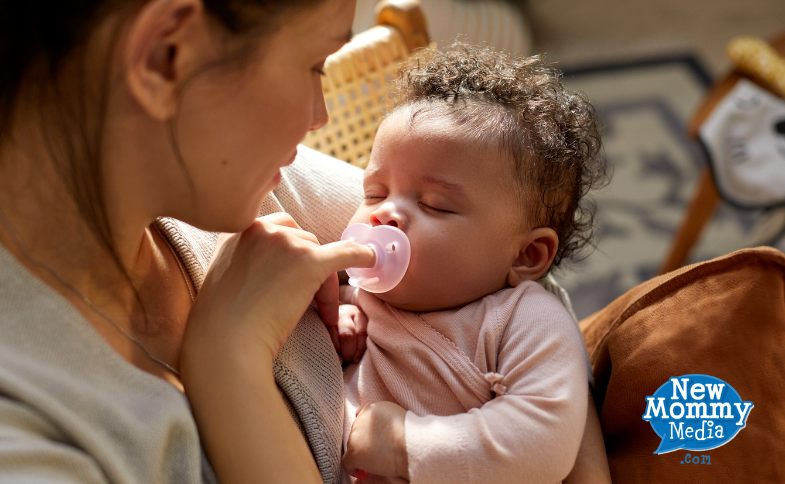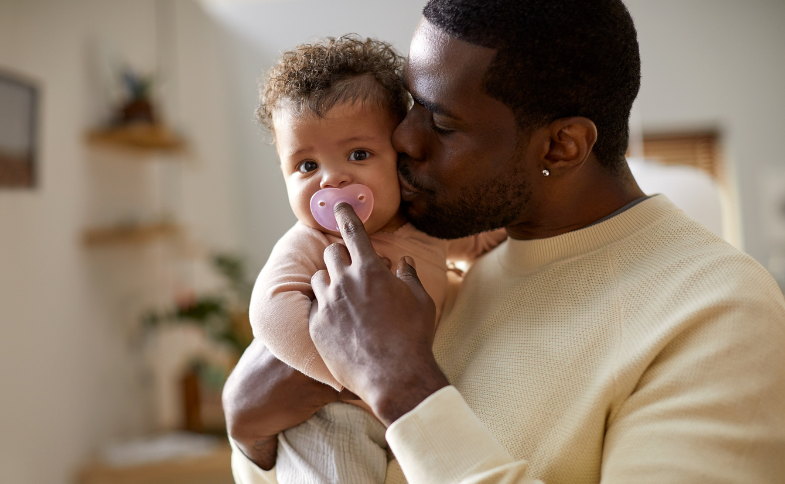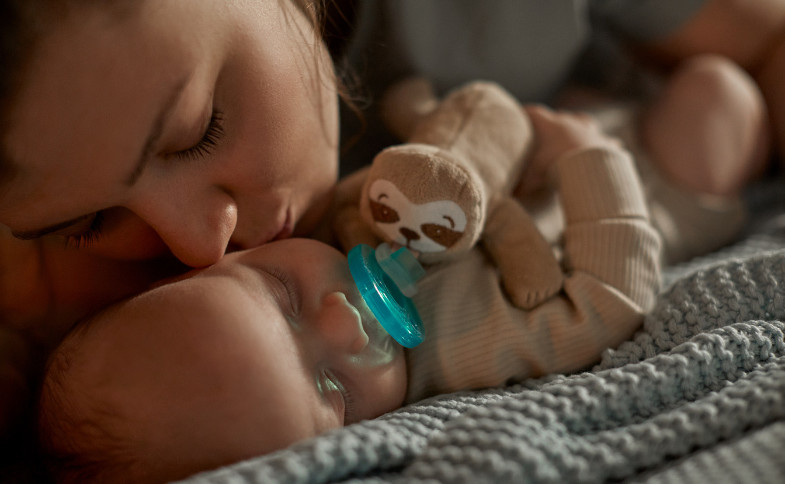The Good, The Bad, and The Ugly with Baby Pacifiers
In this article:
- The benefits of your baby using pacifiers.
- Things to consider when using baby pacifiers.
- How to properly use pacifiers.
- Ways to sanitize and keep the pacifier clean.

Is it OK to use a pacifier when your little one is crying or fussing? Well, according to experts, yes it is! Pacifiers are completely safe and even effective to use. However, you have to use them correctly and plan to wean your little one off them.
Babies love pacifiers because they appeal to their natural urge to suckle. They suck to feed and soothe themselves, and pacifiers fill the latter role perfectly. Because they get babies to suck more, several recent studies suggest that pacifiers could be useful to your little one: they can help reduce the risk of SIDS (Sudden Infant Death Syndrome) while also helping babies gain weight. That said, pacifiers are not perfect soothing tools. They do have a few downsides. For example, it is often quite difficult to wean babies off them.
In this guide, we’ll highlight the good, the bad, and the ugly side of pacifiers.
The Good: What are the benefits of pacifiers?
We all know that pacifiers are magical little tools that can help keep babies calm and content. However, apart from that, did you know that they also offer lots of other benefits to you and your little one? Here are some of them:
- Pacifiers are a great way to soothe babies. Because babies have a natural need to suck on things, they take to pacifiers very quickly. While feeding from the breast or a bottle meets this need, it is only a temporary fix. When the need lingers beyond the feeding session, pacifiers can do the trick. This gives pacifiers a unique soothing ability.
- You can use a pacifier as a temporary distraction. Your baby's pacifier will come in handy when you need to distract them for one reason or another. This is useful in a wide range of situations. For example, during a doctor’s visit when your baby needs to get a shot, you can offer a pacifier to distract them or to calm them down. It also helps to make them feel safe in a strange, new environment.
- Pacifiers are great sleeping aids. Your little one’s pacifier is a great tool for encouraging sleep. It can also be exactly what you need to get them to stay asleep for longer.
- Pacifiers may lower the risk of SIDS. The true cause of SIDS (Sudden Infant Death Syndrome) is unknown. However, the American Academy of Pediatrics (AAP) reported that pacifier use is associated with reducing risk.

The Bad and the Ugly: What are the downsides of pacifiers?
Like all things, pacifiers also have a negative side to them. Here are some of the cons of using pacifiers:
- They can be difficult to keep clean. When using a pacifier, you must be vigilant about cleanliness. Ideally, you have to offer a clean pacifier every time. This means you’ll either need to invest in multiple pacifiers or commit to sanitizing the pacifier frequently as needed. A great option is the Philips Avent Ultra air pacifier, which comes with a case that you can use as a sterilizer, making it easy to clean.
- It can be difficult to wean your baby off them. It is easy for babies to get attached to their pacifiers, especially when they use them daily. This can make it quite difficult to wean them off the pacifiers. The good news is that it can be done if you do it the right way.
How to use a pacifier
Pacifiers come in all sorts of shapes and sizes, therefore, before using any pacifier, ensure that it is the right design and safe for your little one to use. Here is what you need to know when using a pacifier:
- Use the correct size. Most pacifiers come in various sizes like, 0-6 months and 6 months and above. The pacifier should be at least one inch wide to reduce the risk of it being swallowed.
- Listen to your baby. You will usually know right away whether your baby likes a pacifier. If your little one does not like a particular one, they will spit it out and refuse to take it.
- Always clean the pacifier thoroughly. To sanitize a pacifier, all you need to do is boil them in a pot of water or use a sterilizer, like the Philips Avent Premium Sterilizer.
Only use the pacifier to soothe your baby. Before giving your little one the pacifier, first, try to figure out why they may be crying or fussing.

Should you use pacifiers?
Now that you understand both the pros and cons of pacifiers, should you use them?
Well, at the end of the day, this is a deeply personal decision that only you can make. On one hand, it would make your life a lot easier. On the other hand, you might not want to deal with having to wean your little one off it or having to sanitize it multiple times a day. Only you know what’s best for you and your baby.
If you do choose to use a pacifier, we highly recommend that you get a high-quality pacifier that is orthodontic and BPA-free. Philips Avent offers a variety of pacifier styles. We recommend Philips Avent pacifiers because they come in a variety of styles benefitting you and your little one:
- They are designed to conform to your baby’s face. Philips Avent Soothie Heart and Philips Avent ultra soft pacifiers feature a special curved shape that offers maximum comfort as your little one sucks on them.
- They are also designed to supplement bonding. The Soothie range of pacifiers, including Philips Avent Soothie pacifer, which are distributed in hospitals nationwide, has a unique design that allows you to place your finger in the nipple. This way, you can bond with your baby as you help them suckle.
- All Philips Avent pacifiers are compatible with Philips Avent Soothie snuggle, which is a plush toy that is designed to help your baby find and hold the pacifier. The pacifier and toy are completely detachable, making them easy to clean.
Final Thoughts
At the end of the day, pacifiers are as comforting for children as they are convenient, safe, and easy to use and clean. If you have been looking for a great pacifier for your little one, we highly recommend Philips Avent pacifiers.